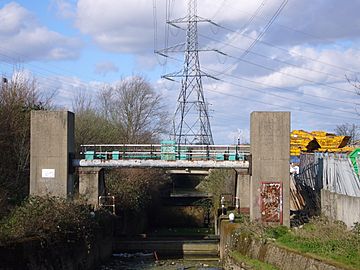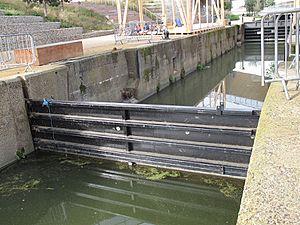Carpenter's Road Lock facts for kids

Carpenter's Road Lock, seen from Marshgate Lane, before the construction of the Olympic Park
|
|
| Waterway | Bow Back Rivers |
|---|---|
| County | Newham Greater London |
| Maintained by | Canal and River Trust |
| Operation | automatic (original) |
| First built | 1934 |
| Length | 92 feet (28 m) |
| Width | 20 feet (6.1 m) |
| Fall | was tidal |
| Coordinates | 51°32′30″N 0°00′59″W / 51.541774°N 0.016437°W |
Carpenter's Road Lock is a very special lock for boats in Newham, London, England. It's found on the Bow Back Rivers, which are waterways that connect to the River Lea and the River Thames. This lock was built between 1933 and 1934. It's unique because it's the only lock in Britain that has "rising radial gates" at both ends. These gates lift up out of the water to let boats pass through.
The lock was once closed off, but it has been brought back to life! It was restored as part of the big changes made for the 2012 Summer Olympics in London. Now, it helps boats travel along the rivers and also helps manage water levels.
Contents
What is Carpenter's Road Lock?
Carpenter's Road Lock is a type of boat lock. It helps boats move between parts of a river that have different water levels. Imagine a giant bathtub with two doors. A boat goes in, the doors close, and the water level inside changes to match the next section of the river.
What makes this lock special are its "rising radial gates." These gates are curved, like a quarter of a circle. Instead of swinging open like regular doors, they lift straight up out of the water. This design is great because it can handle changing water levels. It also helps control floodwaters.
History of the Lock
Why the Bow Back Rivers Needed Help
The Bow Back Rivers are a group of waterways in East London. They connect the River Lea to the River Thames. For a long time, these rivers were used by boats for trade. However, they were not well looked after. No one collected money (tolls) from boats using them, so there was no reason to spend money on their upkeep.
By the 1920s, the rivers were getting blocked up. This meant they could cause floods in the surrounding areas. At the same time, many people in the West Ham area didn't have jobs. The government started a program to help people find work.
Building the Lock
The local council in West Ham worked with the Lee Conservancy Board. They got money to make big improvements to the Bow Back Rivers. A special law, called the River Lee (Flood Relief) Act 1930, allowed this work to happen.
The project began in 1931 and took about four years. It involved cleaning out the rivers and building new structures. A new lock was built at Bow, and another one was rebuilt. Carpenter's Road Lock was a brand new lock built at the northern end of the City Mills River.
Work on Carpenter's Road Lock started in 1933 and finished in 1934. It was built to be 92 feet (28 meters) long and 20 feet (6.1 meters) wide. The engineers chose rising radial gates for this lock. This was a new idea in Britain, though it was common in other parts of Europe. These gates were perfect because the lock needed to do two jobs: let boats through and help control floodwaters. It also had to deal with water levels that could change a lot, sometimes higher on one side than the other.
How the Lock Worked
Each gate had a large frame, called a gantry, built over it. This gantry held heavy weights that helped lift the gates. It also had the machinery to operate them. There were steps up to the gantry, so it also worked as a footbridge across the lock.
When a boat needed to pass, the curved gate would lift completely out of the water. This allowed the boat to go underneath it. A house for the lock keeper (the person who operated the lock) was finished in 1935. The lock was first called Ward's Lock, but soon became known as Carpenter's Road Lock. The lock keeper's house was taken down in 1967.
Carpenter's Road Lock was the only one in Britain with rising radial gates at both ends. Other locks were built with one, but never two. Over time, fewer boats used the Bow Back Rivers. The last time a commercial boat used Carpenter's Road Lock was in the 1960s. By the mid-1970s, the lock was broken and couldn't be used.
Bringing the Lock Back to Life
For many years, the Bow Back Rivers were not a priority for investment. However, in 2002, British Waterways (the group that looked after canals and rivers then) decided that these waterways should be fully restored. The Mayor of London also made sure this was part of the city's plans.
The Olympic Connection
In 2006, London was chosen to host the 2012 Summer Olympics. Many of the Olympic venues were going to be built near the Bow Back Rivers. This was a big reason to fix up the waterways.
Before the Olympics, another lock called City Mills Lock was repaired. Then, a new lock, Three Mills Lock, was built on the Prescott Channel. This new lock helped control the water levels in the Waterworks River. Before, this river was very muddy at low tide. At high tide, boats couldn't fit under a low bridge. Three Mills Lock, finished in 2009, fixed these problems.
Once Three Mills Lock was working, the water levels around Carpenter's Road Lock became much more stable. This made it easier to plan its restoration.
Restoration for the Future
The main Olympic stadium was built very close to Carpenter's Road Lock. To make space for a wide bridge connecting Stratford City to the stadium, the old gantries and ramps of the lock were taken down. The lock was temporarily closed off.
By early 2016, the wide Olympic bridge over the lock was removed. It was replaced by narrower bridges. This allowed the lock to be rebuilt. The Canal & River Trust, which now looks after Britain's waterways, approved a £1.75 million project to restore the lock in February 2016.
Money for the restoration came from different groups. This included the Heritage Lottery Fund, the London Legacy Development Corporation, and the Inland Waterways Association. The plan was to put new gantries back in place. Two new rising radial gates would also be installed. These new gates would allow the lock to work again for boats. They would also help manage floodwaters automatically.
The new gates and control system were designed to be built in small pieces. This was because there wasn't much space to work. The gantries are covered in a special type of steel that rusts to form a protective layer. This rust-colored steel is designed to look different from the shiny stainless steel of the new bridge over the lock.
The restoration means that Carpenter's Road Lock is now a working part of London's waterways once more. It helps boats and protects the area from floods, just as it was designed to do almost a century ago.


